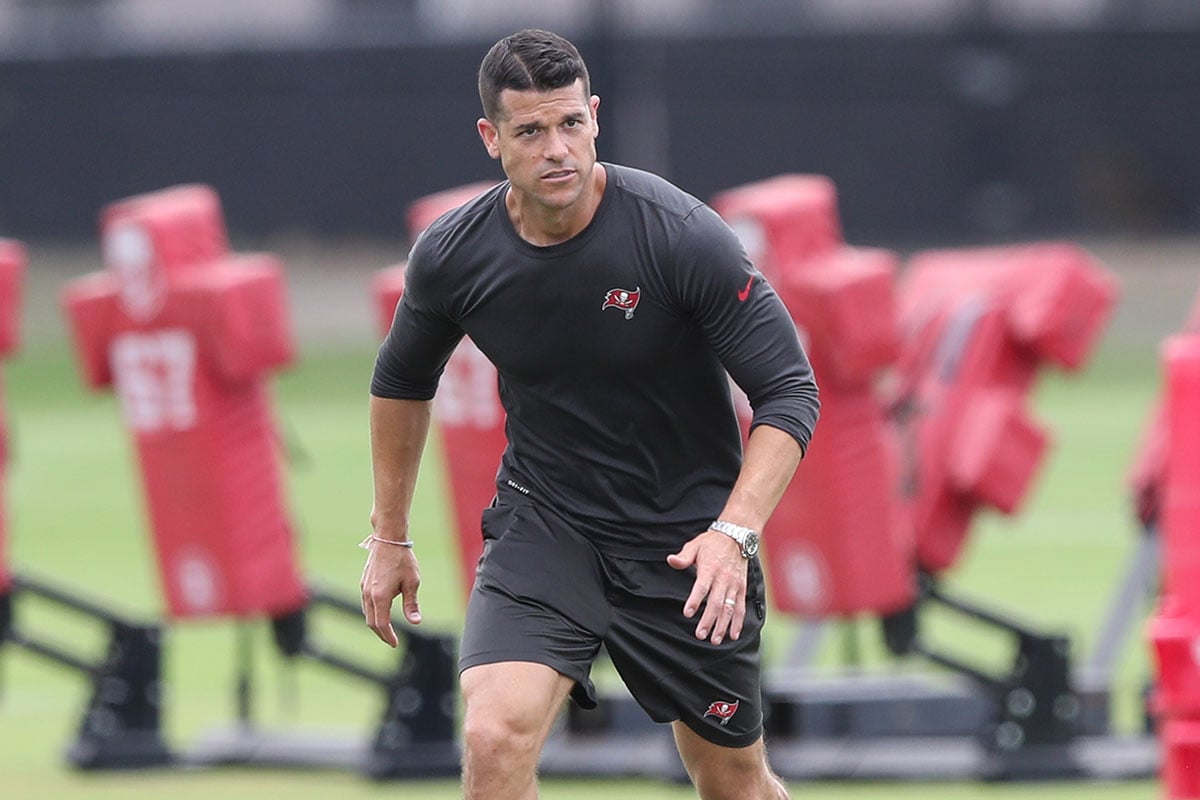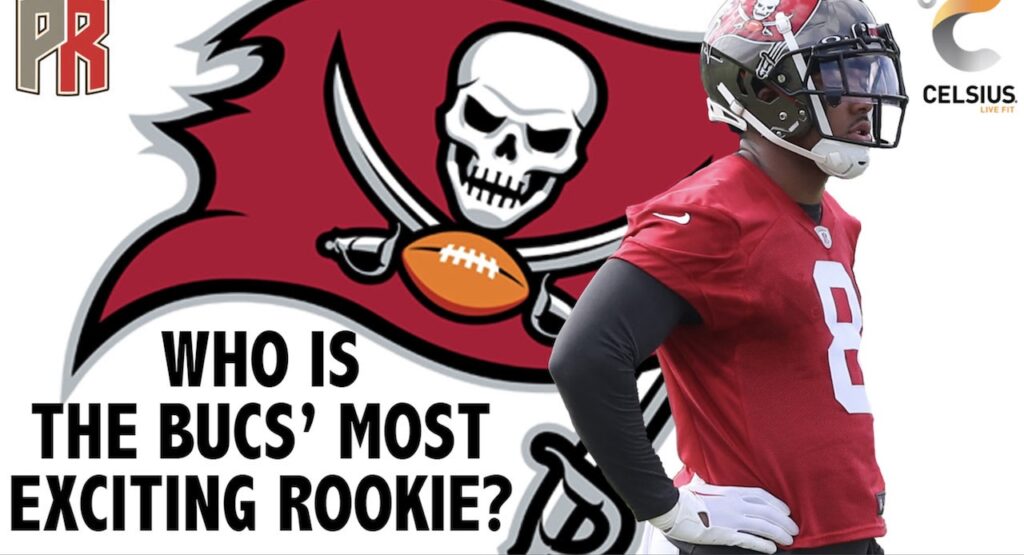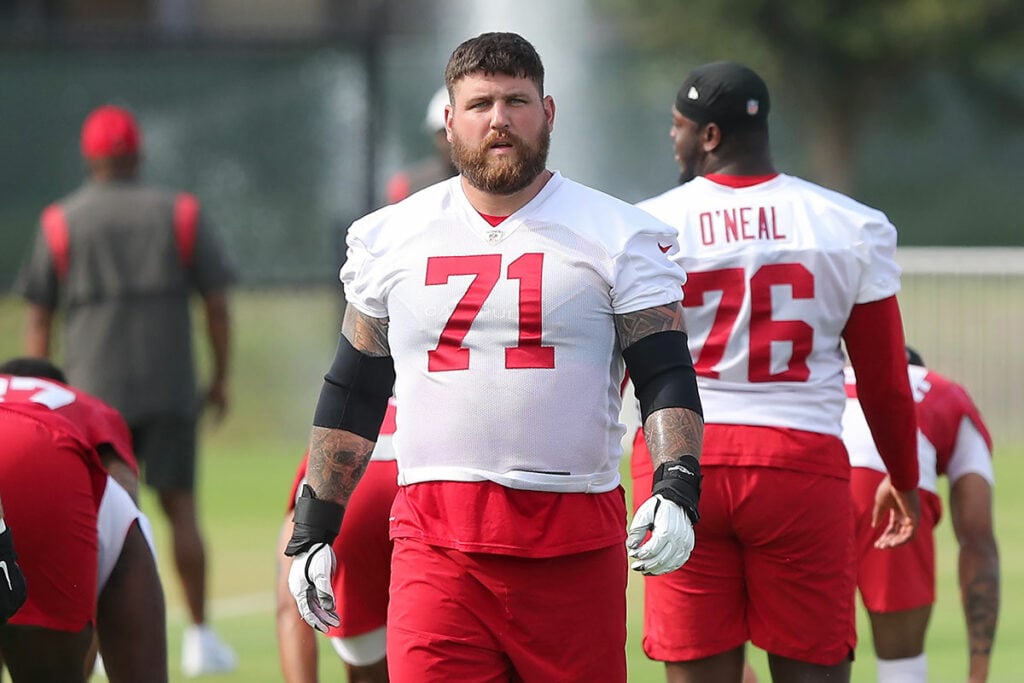Welcome to SR’s Fab 5 – my weekly insider column on the Bucs that features five things that are on my mind. SR’s Fab 5 is now a quicker read, but still packs a punch. Enjoy!
This week’s SR’s Fab 5 column is dedicated to the 5 things that offensive coordinator Dave Canales must do in 2023 to be successful. Last week, I identified 5 things Bucs head coach and defensive play-caller Todd Bowles must do in 2023 to be successful, so if you missed that one, you can read it by clicking here.
FAB 1. Dave Canales Shouldn’t Be Afraid To Show His Hand In The Preseason
Most NFL offensive coordinators will hold their cards close to their vest in the preseason, using the exhibition games in August to simply evaluate players and run vanilla schemes and plays as a result. Why show Week 1 and Week 2 opponents what you might be doing offensively and lose the element of surprise in meaningless preseason games? That’s conventional wisdom around the league, and it makes sense.

Bucs OC Dave Canales – Photo by: Cliff Welch/PR
But for new Bucs offensive coordinator Dave Canales, a first-time play-caller, he shouldn’t be afraid to show his hand in August. That doesn’t mean calling trick plays and emptying out the playbook in the preseason. Yet, Canales needs to see which plays will work and won’t work with certain players in the lineup, so that means some of the plays he plans on calling during the season need to be run in the preseason.
It takes time and game reps for players to master their plays, whether it’s up front forming a pocket as a cohesive offensive line or receivers and tight ends perfecting their routes and timing with the quarterback. While the offense that Canales brought from Seattle is quarterback-friendly and easy to learn, the Bucs won’t have the plays and system down pat by September.
The more the Bucs run certain plays, especially the mid-zone and wide-zone running plays, and the bootlegs, waggles and play-action off it, the better and more comfortable Tampa Bay’s offense will be at executing them.
Canales’ offense features multiple plays that can be run out of the same personnel groupings and the same formations. That alone will be able to disguise and hide what the Bucs plan on doing because they can run half of those plays and save the other half for later in the season to create an element of surprise.
The Bucs ran more duo and gap scheme runs over the last couple of years than they did zone runs. So there will be a bit of a learning curve for Tampa Bay’s offensive line with the zone scheme, especially with an entirely new starting five up front this season. Center Ryan Jensen missed all of last year due to a knee injury and has yet to participate in full-team, 11-on-11 plays.
Tristan Wirfs moves from right tackle to the left side, and Luke Goedeke transitions from left guard to right tackle. Zone blocking calls for offensive linemen to move laterally in concert with each other and it’s important to get the timing down. So Canales needs to call a good amount of zone runs in the preseason to achieve that goal.
Canales also needs to get into a rhythm as a play-caller in the three preseason games and get comfortable calling the plays he’ll want to run in the regular season – as well as the timing that goes along with it. There is a certain time to pull the trigger on a play-action deep shot, and a certain time to call for a naked bootleg. Canales needs to get a game day feel for that and learn when to “zig” when the opposing defense is expecting the Bucs to “zag.”
The Bucs have plenty of talent on offense to physically win a lot of matchups one-on-one. They won’t have to rely on scheme to win on every play, although Canales can do that too with the proven system he’s brought with him from Seattle. He shouldn’t be afraid to let it rip in the preseason, light up the scoreboard and help this young Bucs offense generate some early confidence.
There is some strategy involved in showing a decent number of plays in the preseason and avoid being too vanilla. The more Canales shows, the more opposing defenses like Minnesota and Chicago will have to burn practice time planning for out of the gate.
FAB 2. Don’t Be Afraid To Call An Early Winner In The QB Competition
Dave Canales has said he plans on taking the Bucs quarterback competition all the way through training camp and the preseason if necessary. The longer it goes, the more both Baker Mayfield and Kyle Trask will be competing at the highest level and pushing each other. There is certainly some merit in that plan, and Canales saw it unfold that way in Seattle last year between Geno Smith and Drew Lock. The Seahawks didn’t name Smith the starter until after the third preseason game and it worked out just fine.

Bucs QBs Baker Mayfield and Kyle Trask – Photo by: Cliff Welch/PR
Smith wound up having an even better year than Russell Wilson, the quarterback he replaced, by throwing for over 4,000 yards and making his first Pro Bowl. The 32-year old journeyman also wound up as the NFL’s Comeback Player of the Year. But it should be noted that Smith had spent the 2021 season as Wilson’s backup and already had a rapport with many of the receivers and tight ends, as well as an entire year in the Seahawks’ system.
Mayfield is new to Tampa Bay, and Trask spent his first two seasons in red and pewter throwing the team’s backups and practice-squaders – not Mike Evans and Chris Godwin. Whoever wins the quarterback job will need more reps and more time to fully develop the chemistry necessary to have the offense clicking on all cylinders.
On a recent appearance on the Pewter Report Podcast, Canales said the reason why the Seahawks’ quarterback competition went this distance was because Lock had a great training camp, but that Smith just made a few more plays. Due to his experience and his solid offseason, Mayfield is considered to be the early leader for Tampa Bay’s starting quarterback position.
If Trask doesn’t rise to the occasion and stay stride for stride with Mayfield in camp, then Canales and head coach Todd Bowles would be wise to name the sixth-year vet the starter sooner rather than later.
Whoever wins the starting job will need as many reps as he can in the new offense with new starters to get as ready as possible for Minnesota in Week 1. For that reason, if one quarterback pulls ahead early by a healthy margin, end the competition early and get the starter an increased number of snaps.
FAB 3. Ease Rachaad White Into The Starting Role
The Bucs believe Rachaad White can be an every-down back in Dave Canales’ new offense. His vision and patience combined with his size and speed make him an ideal fit for Tampa Bay’s mid-zone and wide-zone running scheme.
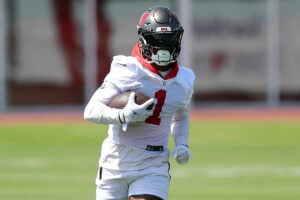
Bucs RB Rachaad White Photo By: Cliff Welch/PR
White played just 589 snaps last year as a rookie, rushing for 478 yards and a touchdown on 129 carries and catching 50 passes for 290 yards and a pair of TDs as the No. 2 back behind Leonard Fournette. That workload is expected to double in 2023 as he replaces Fournette as RB1.
White has added five pounds of muscle to his frame to better withstand the pounding and he changed his jersey number to No. 1 to mentally prepare for being the Bucs’ lead back. But the last time White was a primary ballcarrier was at Arizona State, where he played in just 13 games in 2021. White will see action in at least two preseason games plus 17 regular season games.
Canales would be wise to ease White into the lineup by splitting the carries early in the season with backups Ke’Shawn Vaughn and Chase Edmonds. White should still play the majority of the snaps, but maybe closer to 60% of the workload rather than the 80% that Canales might be tempted to dial up with the 24-year old back.
The Bucs need to do whatever they can to ensure that White is available for the entire season and that he doesn’t have tired legs by the end of the season, especially if Tampa Bay is making a run at another division title. Managing his workload early and understanding that it’s a long season – one with an early bye the first week of October – will go a long way to keeping White fresh for the stretch run.
FAB 4. Master Third-And-Short
Tampa Bay’s offense faltered in 2022 under offensive coordinator Byron Leftwich, who was fired at the end of the season. Scoring dropped from 30 points per game to 18 points per game, and a big reason for that was the Bucs’ shortcomings on third down.
Fewer third down conversions last year led to fewer sustained drives and fewer scoring opportunities. Tampa Bay converted just 38.6% of its third downs last year, which ranked 19th in the NFL. The Bucs ranked fifth in the league in 2021, converting 44.8% of their third downs.
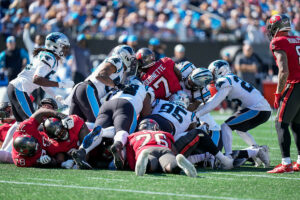
Bucs RB Leonard Fournette – Photo by: USA Today
A big reason for the team’s struggles on third down, especially third-and-short situations, was the fact that the Bucs had the NFL’s worst-ranked running game. Tampa Bay rushed for an average of 75.6 yards per game last year – a 21-yard-per game drop from the 2021 season.
The Bucs converted just 52-of-88 (59%) third-and-short situations last year – defined as third-and-3 or less – after converting 52-of-70 (74%) third-and-short downs in 2021. That was a big drop off that shortened drives and led to too many punts.
If Dave Canales can get the Bucs to master third down, specifically third-and-short situations, there’s no reason why Tampa Bay can’t score more points this season with either Baker Mayfield or Kyle Trask under center than the Tom Brady-led Bucs did last year – as crazy at that sounds.
Tampa Bay ranked ninth with a 44.4% third down conversion percentage in 2020 when the Bucs won the Super Bowl. If Canales can get the Bucs’ ground game going to where what the offense does on third-and-3 and third-and-2 can be a mystery rather than a predictable pass, the result should be more conversions and more sustained drives.
Not only should that lead to more points, but it should also help keep Tampa Bay’s defense fresher by giving that unit an extended break rather than having to take the field again after quick three-and-outs. That’s the type of complementary football head coach and defensive play-caller Todd Bowles wants to play and why he hired Canales in the first place.
FAB 5. Don’t Hesitate To Pull The Trigger At RT Or RG If Necessary
The Bucs have the best of intentions in starting athletic rookie Cody Mauch at right guard and Luke Goedeke, who is entering his second year, at right tackle after a very shaky season at left guard. If both young offensive linemen are up to the task, Tampa Bay’s right side of the line could be one of the nastiest and most aggressive in the league.
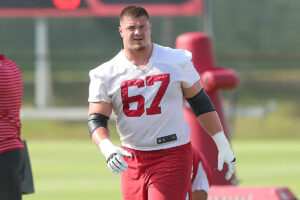
Bucs RT Luke Goedeke – Photo by: Cliff Welch/PR
But head coach Todd Bowles and Dave Canales are rolling the dice due to the lack of experience between Mauch and Goedeke. The team waited too long to pull the plug on Goedeke last year after he really struggled against a litany of Pro Bowl-caliber defensive tackles in the first eight games of the season.
Staying in the starting lineup that long just about wrecked his confidence. But sitting and watching from the sidelines actually benefitted him, so when he started the last two games of the season – at right tackle in Week 18 and back at left guard in the playoffs – he played his best football.
The Bucs believe Goedeke will fare better at his more natural position, as he started his last two years at Central Michigan at right tackle. But if for some reason he struggles – perhaps due to his shorter-than-ideal arm length – Canales can’t wait more than a few games to make a change and insert Matt Feiler or someone else at right tackle.
Nick Leverett proved to be a much better fit at left guard than Goedeke was. The Bucs have plenty of solid options at guard if Mauch turns into this year’s Goedeke and struggles with the transition from North Dakota State to the NFL and the move from left tackle to right guard. Aside from Leverett, reserve center Robert Hainsey can play guard, in addition to John Molchon and Aaron Stinnie if he winds up making the roster.
Canales and head coach Todd Bowles were wise to look at the roster and just pick the starting five based on talent. That allows the offensive line plenty of time in training camp and the preseason to gel and find cohesion. Having an open competition at left guard, right guard and right tackle would have only slowed down the chemistry-building process heading into the season.
It’s okay to allow Mauch a few games to get his feet wet in the starting lineup as a rookie, and for Goedeke to have a few games to readjust to playing outside at right tackle. But Canales needs to have a quick trigger finger in case either player’s development stalls or there is a noticeable decline in their play.
Watch Dave Canales On The Pewter Report Podcast
Check out the recent Pewter Report Podcast with Special Guest: Bucs OC Dave Canales by clicking the link below.
Scott Reynolds is in his 30th year of covering the Tampa Bay Buccaneers as the vice president, publisher and senior Bucs beat writer for PewterReport.com. Author of the popular SR's Fab 5 column on Fridays, Reynolds oversees web development and forges marketing partnerships for PewterReport.com in addition to his editorial duties. A graduate of Kansas State University in 1995, Reynolds spent six years giving back to the community as the defensive coordinator/defensive line coach for his sons' Pop Warner team, the South Pasco Predators. Reynolds can be reached at: [email protected]

